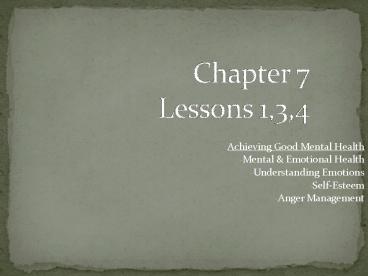Chapter 7 Lessons 1,3,4 - PowerPoint PPT Presentation
1 / 14
Title:
Chapter 7 Lessons 1,3,4
Description:
Achieving Good Mental Health Mental & Emotional Health Understanding Emotions Self-Esteem Anger Management Self Actualization being the best you can be Hierarchy ... – PowerPoint PPT presentation
Number of Views:205
Avg rating:3.0/5.0
Title: Chapter 7 Lessons 1,3,4
1
Chapter 7Lessons 1,3,4
- Achieving Good Mental Health
- Mental Emotional Health
- Understanding Emotions
- Self-Esteem
- Anger Management
2
- Self Actualization being the best you can be
3
Maslows Hierarchy of Needs
- Hierarchy of Needs is a ranked list of needs
essential to growth and development (5 Levels) - Level 1 Physical Needs (Hunger, Thirst, Sleep,
Shelter etc.) These needs must be satisfied in
order to move up (base of pyramid). - Level 2 Safety Needs (Secure from danger)
These needs include the safety of familiar
places, friends, or family.
4
Hierarchy of Needs Cont.
- Level 3 Need to belong. This includes the need
to belong to a group such as a community, family,
or social group. - Level 4 Need to be recognized. This includes
feeling appreciated and being able to do
something well. - Level 5 Need to reach potential. This is the
quest for self-actualization (being the best you
can be).
5
- Personality complex set of characteristics that
makes you unique. - Influences on your personality
- 1) Heredity intellectual abilities,
temperament, or emotional tendencies. - 2) Environment everything around you (friends,
family, - home, school etc.)
- Modeling - observing learning from the people
around you. - PLEASE COMPLETE THE PERSONALITY TEST
- ON A SEPARATE SHEET OF PAPER.
6
.
- Personal identity your sense of yourself
- as a unique individual. This includes your
interests, likes and dislikes, talents/abilities,
values, and goals. - Self Esteem persons value about him or herself
(positive or negative)
7
Forming Positive Self-Esteem/Personal Identity
- Recognize strengths weaknesses
- Positive values
- Develop purpose
- Meaningful relationships
- Contribute to community
- Avoid risk behaviors
- Constructive criticism non-hostile comments
that point out problems encourage improvement - Self-talk listen to what you say replace
negative messages with constructive criticism
8
Emotions
- Emotions signals that tell your mind and body
how to react - Types Emotions
- -happy - sadness -love
- -empathy - fear - guilt
- -anger
- Responding To Emotions
- - Ask yourself what is wrong.
- - Is it worth responding. (will it matter next
week) - - Think about how you are going to respond.
- - Feel negative? Seek positive feelings to
inspire yourself. (exercise) - - Negative feelings dont go away. (seek help)
9
- Defense Mechanism mental process that protects
individuals from strong emotions - Repression- Involuntarily pushing feelings out of
thought. - Suppression- consciously pushing feeling out of
thought. - Rationalization- make excuses instead of taking
responsibility
10
Defense Mechanisms cont.
- Regression- acting immature
- Denial- unconscious lack of acknowledgement that
is obvious to others. - Compensation- making up for mistakes through
gift-giving or extreme efforts.
11
Anger Management Skills
- Do something to relax
- Re-channel your energy
- Talk to someone you trust
- Get physical Activity
- What Are Some Ways You Handle Your Anger?
12
(No Transcript)
13
- Anger Cues- bodily changes during anger
- Breathing sweating increase
- Heart Rate BP increase
- Dry mouth
- Decreased sensitivity to pain
- Increased muscle strength
- Facial cues (eyebrows, lips, red face)
14
- Anger trigger- what causes the anger
- What are some of your anger triggers? Please
complete the section on your notes that asks
about anger triggers and anger management
techniques. - Displacement taking your anger
- out on something or someone else. -gt































